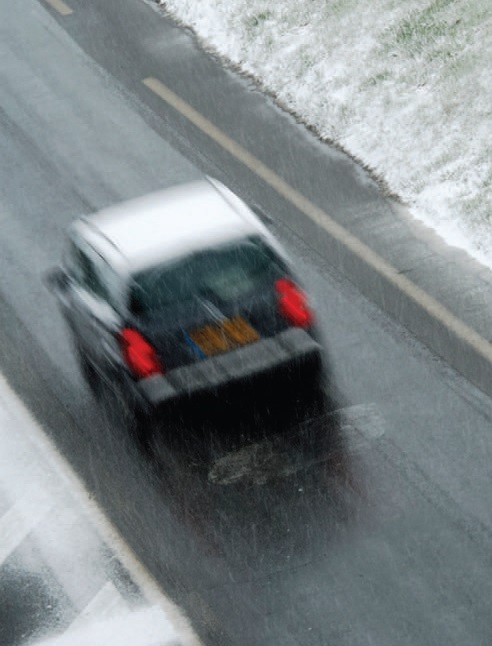Snow, ice and friction
R. David Whitby | TLT Worldwide May 2010
The amount of force to overcome an object’s inertia is greater than the amount of force to keep it moving.

Many motorists find that it is easier to get a front-wheel drive car going on ice compared with a rear-wheel drive car.
www.canstockphoto.com
With the cold and snow in Northern Europe and North America behind us, I am reminded of the value of high coefficients of friction in which well-designed rubber tires provide a good grip on dry roads. But why is it possible to drive on snow but much more difficult to drive on ice? Why is it more difficult to get moving on an icy road but easier to keep moving once you’re going? What about the problem of stopping?
Friction, a force that opposes motion in a particular direction, occurs when the surfaces of two materials come into contact with each other. Since no surface is completely smooth, there will always be a frictional force that opposes motion. The magnitude of this friction depends on the surfaces’ materials, including their respective roughness, temperature, the normal force and other factors.
Tribologists usually describe two types of friction. Static friction prevents motion from occurring altogether and occurs when objects are stationary. Kinetic friction impedes motion already in progress. The coefficients of static and kinetic friction have different values; the amount of force needed to overcome an object’s inertia is greater than the amount of force needed to keep it moving.
There is another type of friction: rolling friction (also called rolling resistance). When a cylinder rolls on a surface, the force resisting motion is termed rolling friction. It is generally considerably less than sliding friction. Rolling friction is caused primarily by the interference of small indentations formed as one surface rolls over another.
Many textbooks assume that ice is a frictionless surface, which is untrue. Ice seems to be a frictionless surface because it is flat, smooth and slippery when you run your hand across it. According to many experts, the coefficient of friction on ice is not constant; it is just too difficult to find the exact value.
The Physics Factbook, edited by Glenn Elert, lists some values for coefficients of friction on ice. The coefficient of kinetic friction of rubber on ice is 0.15, for a curling stone on ice it is 0.0168 and for special ice skates it is 0.0046. I have not been able to find values of coefficients of static or rolling friction for rubber on ice (Coefficients of kinetic friction for rubber on wet asphalt range from 0.25 to 0.75).
Motorists driving on snow and ice suggest the coefficient of rolling friction is higher than that for either static or kinetic friction. A rear-wheel drive car will always over-steer on ice; it will want to keep turning too far into a corner, resulting ultimately in a spin. Conversely, a front-wheel drive car will generally under-steer into an icy corner; it will appear to want to keep driving straight on.
Many motorists find that it is easier to get a front-wheel drive car going on ice compared with a rear-wheel drive car. It is easier for the front wheels to pull a car along than for the rear wheels to push it, particularly for icy or wet surfaces.
The friction between the tires and the road determine the maximum acceleration and, more important, the minimum stopping distance. So the nature of friction could actually be a matter of life and death. Many years of research and practice have led to tread designs for car tires, which offer good traction in a wide variety of conditions. Additionally, in many cold countries, drivers use either snow chains or studded tires during the winter to raise the friction between the wheels and the snow or ice.
When roads are covered in snow or ice, drivers should try to maximize the friction between the tires and the road by starting slowly, going from static friction to rolling friction as quickly as possible, while avoiding sliding friction. Braking also should be done as gently as possible, going from rolling friction to static friction, again while avoiding sliding friction. Similar actions apply to walking on snow and ice.
Of course, if you’re skiing, playing ice hockey or curling, you will want the coefficient of kinetic friction on ice to be exactly as low as you desire.

David Whitby is chief executive of Pathmaster Marketing Ltd. in Surrey, England. You can reach him at
pathmaster@dial.pipex.com.